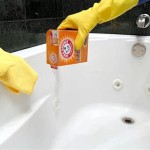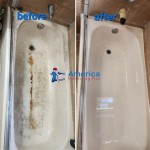Home Remedies To Clean Enamel Bathtub
Enamel bathtubs, prized for their durability and classic aesthetic, can accumulate soap scum, hard water stains, and general grime over time. While commercial cleaning products are readily available, many homeowners prefer using home remedies to clean enamel bathtubs. These alternatives often utilize readily available ingredients, are environmentally friendly, and can be just as effective at restoring the tub's shine. Furthermore, homemade cleaning solutions tend to be gentler on the enamel surface, potentially prolonging its lifespan by avoiding harsh chemicals.
The key to successfully cleaning an enamel bathtub with home remedies lies in understanding the nature of the stains and choosing the appropriate cleaning agent. Different stains require different treatments. For example, soap scum, primarily composed of fatty acids and minerals, may be best tackled with acidic solutions. Hard water stains, consisting mainly of calcium and magnesium deposits, also benefit from acidic cleaners. Grime and dirt, on the other hand, might respond better to alkaline cleaners or abrasive methods.
Before applying any cleaning solution, it is crucial to test it on a small, inconspicuous area of the bathtub to ensure it does not damage or discolor the enamel. This step is especially important when using abrasive cleaners or substances with high acidity levels. Proper ventilation is also essential when working with cleaning agents, even those considered natural, to avoid inhaling potentially irritating fumes.
Baking Soda and Vinegar
Baking soda and vinegar represent a classic combination for tackling various cleaning tasks around the home, including enamel bathtub cleaning. Baking soda, a mild abrasive and alkaline substance, helps loosen grime and soap scum. Vinegar, a weak acid, effectively dissolves mineral deposits and hard water stains. When combined, their reaction produces carbon dioxide gas, which can further aid in lifting dirt and debris from the surface.
To use this method, begin by rinsing the bathtub with warm water to loosen any surface dirt. Next, generously sprinkle baking soda over the entire surface of the tub. Pour white vinegar into a spray bottle and spritz the baking soda-covered surface. A fizzing reaction will occur as the vinegar interacts with the baking soda. Allow the mixture to sit for approximately 20-30 minutes, depending on the severity of the staining. For stubborn stains, create a paste of baking soda and water and apply it directly to the affected area. Let the paste sit for a longer period, up to an hour or more, before scrubbing.
After the soaking period, use a non-abrasive sponge or cloth to scrub the bathtub. Focus on areas with visible stains or buildup. The baking soda-vinegar mixture should help loosen and dissolve the grime. Rinse the bathtub thoroughly with warm water to remove all traces of the cleaning solution. A final wipe-down with a clean, dry cloth will help prevent water spots and leave the enamel surface sparkling.
While generally safe for enamel surfaces, prolonged exposure to vinegar, especially in high concentrations, can potentially etch or dull the finish. It is therefore important to avoid leaving the vinegar on the surface for extended periods and to always rinse thoroughly after cleaning. The baking soda acts as a buffer in this process, mitigating the harshness of the vinegar, especially when used together.
For added cleaning power, consider adding a few drops of dish soap to the baking soda-vinegar mixture. Dish soap helps to cut through grease and oil, which can be particularly helpful for removing stubborn soap scum. Essential oils, such as tea tree or lavender, can also be added for their antibacterial properties and to impart a pleasant scent.
Lemon Juice and Salt
Lemon juice, another readily available acidic cleaning agent, can effectively remove hard water stains and soap scum from enamel bathtubs. The citric acid in lemon juice acts as a natural solvent, breaking down mineral deposits and grime. Salt, a mild abrasive, further aids in scrubbing away stubborn stains without scratching the enamel surface.
To use this method, cut a lemon in half and sprinkle salt generously over the cut surface. Use the lemon half as a scrubbing tool, applying gentle pressure to the stained areas of the bathtub. The combination of lemon juice and salt provides both chemical and mechanical cleaning action. The acidity of the lemon juice dissolves the mineral deposits, while the salt acts as a gentle abrasive to dislodge the grime.
Alternatively, lemon juice can be applied directly to the stains using a spray bottle or a sponge. Allow the lemon juice to sit on the surface for approximately 30 minutes to an hour, depending on the severity of the staining. Then, sprinkle salt over the lemon juice-soaked areas and scrub with a non-abrasive sponge or cloth. Rinse the bathtub thoroughly with warm water to remove all traces of lemon juice and salt.
Lemon juice is generally considered safe for enamel surfaces, but prolonged exposure can potentially cause discoloration or etching. It is important to test the solution on a small, inconspicuous area before applying it to the entire bathtub. Avoid leaving the lemon juice on the surface for extended periods and always rinse thoroughly after cleaning.
For added cleaning power, consider combining lemon juice with baking soda. This mixture creates a fizzing action similar to the baking soda-vinegar combination, which can further aid in lifting dirt and debris from the surface. Essential oils, such as lemon or grapefruit, can also be added for their antibacterial properties and to enhance the citrus scent.
The natural bleaching properties of lemon juice can also help to brighten the enamel surface and remove discoloration caused by stains. Regular use of lemon juice as a cleaning agent can help to maintain the shine and cleanliness of the bathtub.
Cream of Tartar and Hydrogen Peroxide
Cream of tartar, a mild abrasive and acidic substance commonly used in baking, can be combined with hydrogen peroxide to create a powerful cleaning paste for enamel bathtubs. Hydrogen peroxide, a mild bleaching agent, helps to lighten stains and disinfect the surface. This combination is particularly effective for removing stubborn stains and restoring the brightness of the enamel.
To create the cleaning paste, mix equal parts cream of tartar and hydrogen peroxide in a small bowl. The mixture should form a thick paste. Apply the paste directly to the stained areas of the bathtub using a clean cloth or sponge. Allow the paste to sit on the surface for approximately 30 minutes to an hour, depending on the severity of the staining.
After the soaking period, use a non-abrasive sponge or cloth to scrub the stained areas. The cream of tartar acts as a gentle abrasive to dislodge the grime, while the hydrogen peroxide helps to bleach and disinfect the surface. Rinse the bathtub thoroughly with warm water to remove all traces of the cleaning paste.
Hydrogen peroxide can have a bleaching effect on certain materials, so it is important to test the paste on a small, inconspicuous area of the bathtub before applying it to the entire surface. Avoid using high concentrations of hydrogen peroxide, as this can potentially damage the enamel finish. A 3% solution of hydrogen peroxide, commonly available at drugstores, is generally safe for cleaning purposes.
For added cleaning power, consider adding a few drops of dish soap to the cream of tartar and hydrogen peroxide paste. Dish soap helps to cut through grease and oil, which can be particularly helpful for removing stubborn soap scum. Essential oils, such as tea tree or lavender, can also be added for their antibacterial properties and to impart a pleasant scent.
When working with hydrogen peroxide, it is important to wear gloves to protect your skin from irritation. Avoid getting hydrogen peroxide in your eyes. If contact occurs, rinse thoroughly with water. This cleaning method, when applied carefully, can significantly improve the appearance of an enamel bathtub, removing stains and restoring its original shine.
The effectiveness of these home remedies depends on the severity of the stains and the frequency of cleaning. Regular cleaning prevents stubborn stains from forming and makes the cleaning process easier. Additionally, proper ventilation is important when using any cleaning agent, even natural ones. By utilizing these home remedies, homeowners can effectively clean and maintain their enamel bathtubs, avoiding harsh chemicals and prolonging the lifespan of their fixtures.

3 Ways To Clean An Enamel Bathtub Wikihow

Tips On How To Remove Bathtub Stains Naturally

How To Clean Your Bathtub The Home Depot

Baking Soda Bleach And Vinegar Which Is Best For A Clean Bathtub 2025

How To Clean A Bath Complete Guide Elegant Showers

4 Household S That Remove Stains From Your Bath

3 Ways To Clean An Enamel Bathtub Wikihow

How To Clean Tough Stains From A Bathtub 4 Easy Methods

Cleaning The Bathtub Best Tips Home Remedies

3 Easy Ways To Clean Porcelain Tubs Without Scratching
Related Posts








